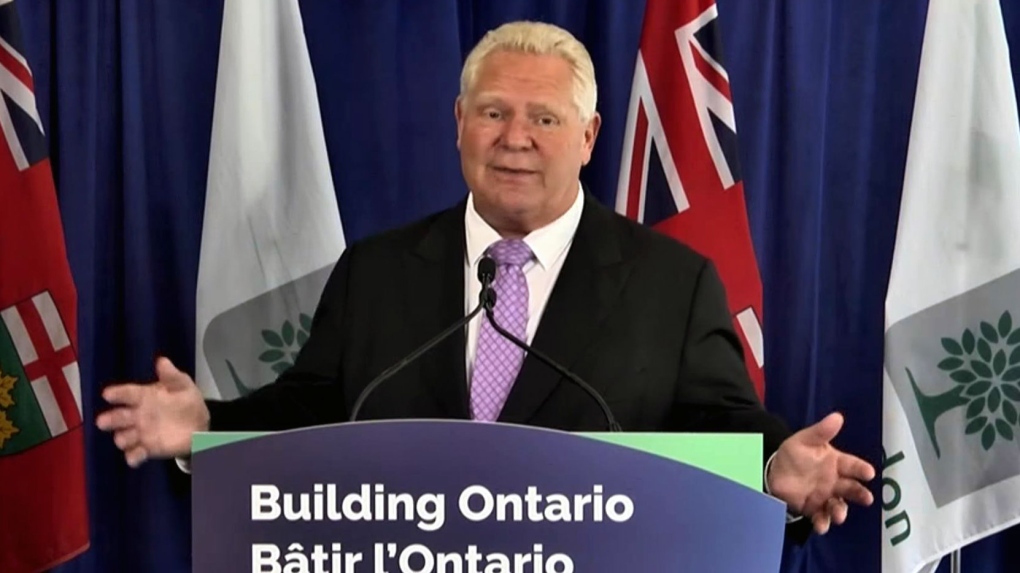Provincial funds to replace sewage pipe beneath Forks of the Thames preventing more residential growth downtown
London’s building boom has pushed the downtown to the limit of its sewage capacity.
On Monday, Ontario Premier Doug Ford was in London to announce an investment of almost $24 million to support more residential development in the downtown core.
The provincial contribution will offset about three-quarters of the cost to install a larger pipe to carry sewage from Downtown London to the Greenway Wastewater Treatment Plant.
City hall is picking up the remaining costs.
“How can you build more homes if you don’t have proper water, wastewater, and sewer systems to build the homes?” asked Ford. “So we’ve stepped up in a big way.”
Eliminating the sewage bottleneck will unlock capacity to build an additional 17,576 residential units in the downtown.
“We are fully committed to the province's goals of building more housing in this community, and that is why the infrastructure in the City of London is so incredibly important,” said Mayor Josh Morgan.
The current pipe that runs beneath the forks of the Thames was installed in the 1930s.
 Ontario Premier Doug Ford speaks in London, Ont. on Aug. 26, 2024. (CTV News file image)
Ontario Premier Doug Ford speaks in London, Ont. on Aug. 26, 2024. (CTV News file image)
Installation of the new pipe will avoid disturbing the sensitive ecosystem by tunnelling beneath the river.
“We’ll be micro-tunneling the new sewer underneath the river,” explained Ashley Rammeloo, director of Water, Wastewater, and Stormwater.
Micro-tunneling is a state-of-the-art construction technique that gradually digs a tunnel while simultaneously forming the sewer to prevent a collapse.
The technique has been used in a handful of other projects in London where digging a trench is not feasible.
The new pipe will be installed in 2025, permitting a number of new residential high-rise projects in Downtown London to break ground.
CTVNews.ca Top Stories

Liberal cabinet has 'tremendous confidence' in Prime Minister Trudeau despite polling
Members of the Liberal government cabinet say they have 'tremendous confidence' in Prime Minister Trudeau despite polling numbers and questions surrounding his leadership.
Conservatives pledge to force Tom Clark testimony on $9M NYC condo purchase
Conservative ethics critic Michael Barrett says his party will move a motion to force testimony from Canada's representative in New York if he does not appear at a Tuesday committee study into the purchase of a $9-million condo in Manhattan.
Woman found dead in suspected femicide in Ottawa's west end
A 47-year-old woman is dead after a suspected femicide inside a home in Ottawa's west end on Sunday evening.
B.C. man sentenced for 'callous' indignity to remains of young man found dead in 2016
A B.C. man acted with a "chilling sense of calm" when he took "deliberate steps to conceal and dispose of" the body of a young man he met online nearly eight years ago, according to a provincial court judge.
'Buyers are firmly in the driver's seat': It's a good time to buy a cottage in Canada, experts say
As the weather cools down across Canada, so too is the cottage market, with real estate experts saying now is the time to purchase that cottage you've had your eyes on.
Immigration minister says upcoming changes to permanent resident levels 'not cosmetic,' but 'significant'
Immigration Minister Marc Miller says the federal government is 'looking at a number of options' to re-evaluate permanent resident levels in Canada and says any upcoming changes will not be 'cosmetic' but 'significant.'
Mariah Carey's mother and sister died on the same day. The singer says her 'heart is broken'
Mariah Carey's mother Patricia and sister Alison both died on the same day, the singer said Monday.
Fraudsters posing as Amazon employees scam Gatineau, Que. victim for $12,000
A Gatineau, Que. resident has fallen victim to a phone scam that resulted in the loss of $12,000, but TD Bank has declined to reimburse the funds.
London Drugs employee sentenced for stealing $2M in laptops, electronics from company
A 34-year-old London Drugs employee has been sentenced to two years in prison for stealing approximately $2 million in merchandise from the company over the course of five years.


































